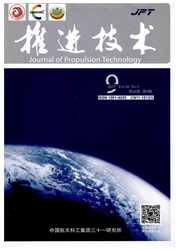

 中文摘要:
中文摘要:
为验证等离子体助燃改善航空煤油贫油燃烧性能的可行性,研制了圆管型介质阻挡放电等离子体助燃激励器,开展等离子体辅助航空煤油贫油燃烧的验证试验,分析等离子体激励参数(电源占空比、工作介质流量、放电电压)对燃烧性能(燃烧效率、贫熄边界)的影响,并与未施加等离子体助燃激励时的性能参数进行比较,同时对等离子体强化航空煤油贫油燃烧的原因进行了初步分析。实验结果表明,电源占空比或助燃激励器工作介质流量减小、放电电压增大时,燃烧效率增大、贫熄边界扩大,且施加等离子体助燃激励后燃烧性能均有一定程度的提高;圆管型空气介质阻挡等离子体放电产生的O3是等离子体强化航空煤油贫油燃烧的主要因素。
 英文摘要:
英文摘要:
To verify the feasibility of improved lean-fuel combustion performance of aviation kerosene with plasma assistance,a cylindrical plasma-assisted combustion actuator(PACA) using dielectric barrier discharge(DBD) was designed to conduct the validation tests of plasma-assisted combustion(PAC) of leanfuel aviation kerosene. The impact of plasma excitation parameters including duty ratio of power supply,feedstock gas flow rate,and applied voltage on combustion performance including combustion efficiency and weak limit of combustion stability was analyzed and the results were compared with normal combustion of lean kerosene- air mixture without plasma assistance. The preliminary reason that plasma enhances combustion performance of lean aviation kerosene was also analyzed. Experimental results show that the decrease of duty ratio of power supply or feedstock gas flow rate,as well as the increase of applied voltage leads to the increase of combustion efficiency and expansion of weak limit of combustion stability,and combustion performance is improved to some extent when plasma-assisted combustion excitation is applied. The main factor that plasma enhances leanfuel combustion performance of aviation kerosene is the generation of O3 during DBD's air plasma discharge in cylinder PACA.
 同期刊论文项目
同期刊论文项目
 同项目期刊论文
同项目期刊论文
 期刊信息
期刊信息
